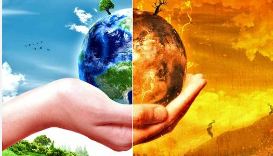Climate change is no longer a distant threat—it is a present and intensifying reality, especially for third world countries like Pakistan. While the global community is grappling with the consequences of rising temperatures, it is the economically weaker nations that bear the heaviest burden. These countries, despite contributing the least to global greenhouse gas emissions, are the most vulnerable to the climate crisis due to inadequate infrastructure, limited resources, and socio-political challenges.
Pakistan exemplifies this disparity. Ranked among the top ten countries most affected by climate change, Pakistan experiences frequent and severe natural disasters, such as floods, droughts, and heatwaves. The catastrophic floods of 2022 submerged one-third of the country, affecting over 33 million people and causing damages worth billions of dollars. Crops were destroyed, homes were swept away, and essential infrastructure was crippled. The agricultural sector, which employs a large portion of Pakistan’s population, is increasingly unpredictable due to changing rainfall patterns and extreme weather, threatening food security and rural livelihoods.
Moreover, rising temperatures and glacial melt in the northern regions are endangering Pakistan’s water supply. The country depends heavily on glacier-fed rivers, and as glaciers retreat, the risk of both floods and future water shortages grows. Urban areas also suffer as prolonged heatwaves, combined with power shortages, impact public health and productivity.
The impacts of climate change are not limited to environmental degradation; they exacerbate existing socio-economic inequalities. The poor, who often live in vulnerable areas and lack the means to recover from climate-related disasters, are pushed deeper into poverty. Children miss school during floods, families are displaced, and healthcare systems are overwhelmed. Climate change, in this context, is not just an environmental issue—it is a humanitarian crisis.
So, how can Pakistan and other third world countries cope with this mounting challenge?
First, there must be a renewed focus on climate-resilient infrastructure and disaster preparedness. Building flood defenses, improving drainage systems, and constructing climate-resilient homes can save lives and reduce economic losses. Investment in early warning systems is essential to give communities time to prepare and evacuate if needed.
Second, international support is critical. Wealthier nations have a moral and historical responsibility to assist the Global South through climate finance, technology transfer, and capacity-building. Initiatives like the Loss and Damage Fund established at COP27 must be implemented swiftly and transparently, with developing countries having a seat at the decision-making table.
Third, at the national level, Pakistan must prioritize sustainable development and environmental protection. Transitioning to renewable energy, reforestation, and public awareness campaigns can play significant roles in reducing vulnerability. Strengthening institutions and enforcing environmental regulations is equally crucial.
In conclusion, climate change is an existential threat to Pakistan and many other third world nations. The time for urgent, collective, and sustained action is now. Both domestic reforms and international solidarity are essential if we are to protect millions of lives and secure a livable future for the generations to come.

















